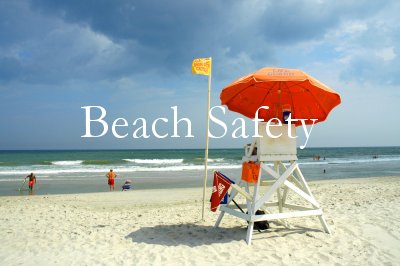
One of the biggest mistakes Myrtle Beach visitors can make is confusing the ability to swim with the ability to swim in the ocean. There's a big difference between paddling around in a calm swimming pool and venturing into something as beautiful yet powerful as the Atlantic Ocean.
Crashing waves, changing tides and powerful rip currents can create issues for newcomers to the environment. Inclement weather – often far offshore an invisible to the naked eye – is also a factor. Heavy winds often cause larger waves and swells, which can be particularly hazardous to children and the elderly. Even wading through the surf can create a slip into a rip current.
Don't let the potential dangers keep you from enjoying a day at the beach. Just follow a few simple rules, and the advice of your local lifeguard, for some safe and drama-free fun in the ocean:
* If you are a moderate swimmer or have little experience in the ocean, take some time to get used to the conditions in a safe setting. Start by splashing around in the surf and feeling the effects of the waves. When you are feeling confident, go just beyond the breakers and work on your strokes. If at any time you start to feel uncomfortable, simply ride a wave back in and try again later. No matter how accomplished you are as a swimmer, never paddle out too far as deeper waters often have stronger currents. Remember, however far you swim out is how far you must swim back, so don't venture out beyond your abilities and energy level.
* Don't be too embarrassed to wear a life vest, or carry a boogie board or other floatation device with you as a safety net. Of course, you might not be able to hold on to a board if you are hit by a big wave, and a loose-fitting life preserver could easily be removed by the force of the water. It's important to use a US Coast Guard-approved life jacket that is snug fitting and properly worn. That's especially true for small children playing in the surf, where a wave or rip current could pull them in. Water Wings or other swimming aids won't cut it in the ocean.
* Guests at Long Bay Resort in Myrtle Beach are fortunate to have public lifeguards on duty along the stretch of beach around the resort, but they are on duty only from 10 a.m. to 5 p.m. during summer days. If you have children or inexperienced ocean swimmers in your party, set up near a lifeguard stand for a little extra attention. Pay attention to the flags that fly from the lifeguard chairs. Similar to a traffic light, a green flag means good conditions, yellow means use caution, and red means no swimming. These signals can also apply to water quality as well as surf conditions. The only unfamiliar flag you may see is purple, signifying dangerous marine life was spotted in the area. This could apply to jellyfish or schools of feeding fish near the shore.
* Rip currents are by far the biggest danger on the beach. Formed by gaps in sand bars that create strong outflowing currents, particularly during a falling tide, rip currents are capable of pulling expert swimmers out to deeper waters. The key is to keep your head if you find yourself being towed offshore. Resist the urge to swim against the current; you will only wear yourself out. The best course of action is to swim parallel to the shore, which will allow you to escape the flow and swim safely back to the beach. Be sure to wave, scream or signal a lifeguard or bystander to let them know you need assistance.
(Posted: 5/21/15)

